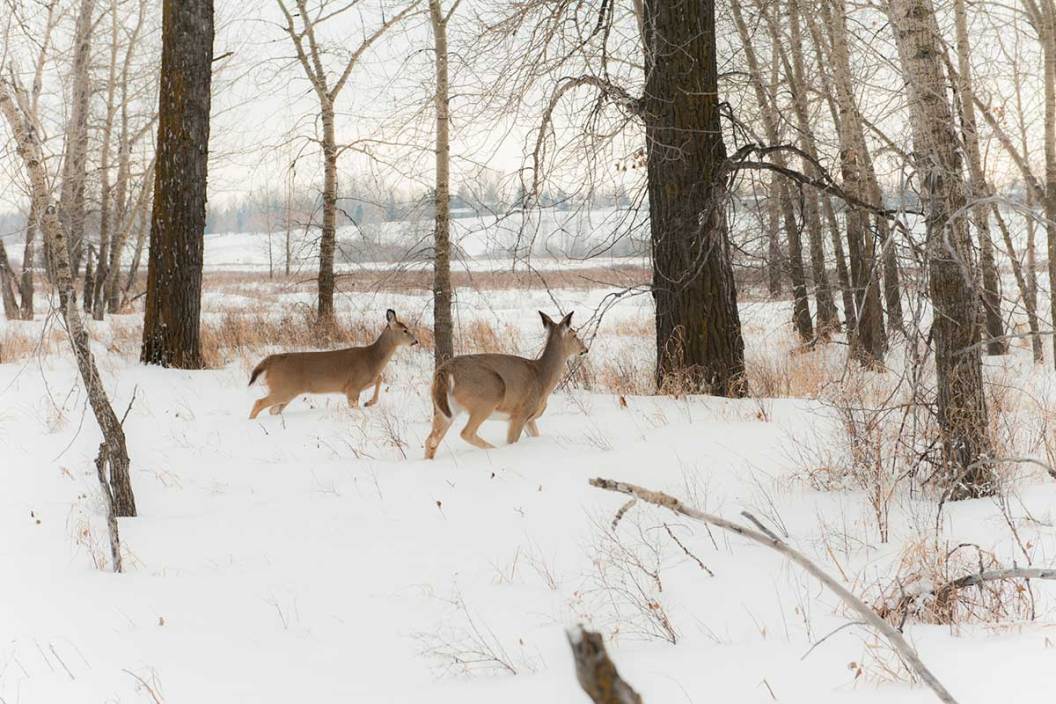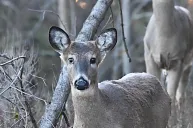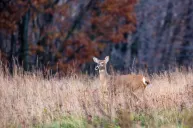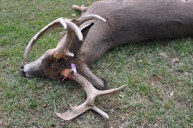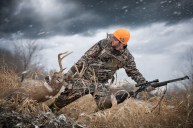Here's the info behind antlerless deer tags, antlerless seasons, and antlerless deer permits, plus reasons why they're meaningful management tools.
We do not become expert hunters after our first kill.
For nearly every hunter you see that harvests a mature buck, there are dozens of doe and small buck harvests behind them or their mentors that gave them the expertise to finally land a giant. The fact that we have antlerless tags and special antlerless hunting seasons is crucial for both hunters and whitetail.
Not only does harvesting antlerless deer pad a hunter's experience, knowledge, and freezer, but it also helps the deer population, locally, statewide, and ultimately nationwide, in more ways than you may think.
How Antlerless Seasons Benefit Whitetail Deer
While it may sound counter-intuitive at first, taking out a few antlerless deer within the bag limits can actually help a deer population prosper in the long term. If we are strategic about it, we can ensure that the does we do keep are well fed and produce as many fawns as possible.
Personally, when I am after a doe on private land, I will take the oldest, most mature doe I see if there is a group of them. I think most hunters also try to do the same. Taking out these older does will give the younger ones more resources, which will lead to healthier deer, better fawn production, and eventually better deer hunting overall.
For example, a 4-year-old doe may live for 4 or more years if she is smart. Although it is unlikely that she will remain fertile the rest of her life or produce multiple fawns in a year. All the while she will consume resources.
If there is a 1- to 3-year-old doe in the same group, you can bet that doe is going to have a better chance of breeding. Since she is younger, it is more likely she is going to produce more fawns over the next five years than the older doe. So we elect to shoot the older doe and give the deer with the highest probability of producing more fawns a pass.
Although even if you take a few younger does, that would keep them from consuming resources and could help the overall population if there are too many does around. It just doesn't help as much with fawn production in the long term.
Even Out The Buck to Doe Ratio
Taking additional antlerless deer can also help level out the buck to doe ratio. It is natural for there to be more bucks than does in a deer population. Although hunting caters to shooting bucks, so in most areas buck numbers are not nearly as high as they should be.
A whitetail buck can breed around 7 to 8 does during the rut. The natural buck to doe ratio is around 3 to 5 does for every buck. So in an un-hunted population, a buck will never reach its breeding limit.
With a bad ratio, there could be 10 does to every buck on an over-hunted property. At that ratio, bucks are not going to be able to breed every doe. The older does may come into estrus and be bred, but they have a higher chance of a failed pregnancy or difficulty rearing.
By harvesting older does, we give all the other deer more resources and opportunities to grow. Younger does are destined to produce more fawns in the long run. Plus bucks that benefit from the extra resources will be able to grow bigger than they would before. The deer herd, overall, is improved.
Of course, this does not mean you should shoot every doe you see because you think once the bucks have all the resources they'll grow as big as possible. You still need a large doe population for a healthy herd. However, if there are significantly more does than bucks, harvesting around 3 to 5 does each deer hunting season will quickly bring the ratio back in balance. Just make sure to know about how big the deer population is so you don't harvest more than is sufficient.
How Antlerless Tags Benefit Hunters
Not only are antlerless tags a good thing for the herd, but they are very valuable for hunters. The obvious benefit of antlerless permits and tags is the ability to fill the freezer. Deer taste good, and if you kill a few every season you can have enough to eat for most of the year. The ability to feed your family by yourself and not have to rely on the grocery store supply chain is a freedom that we are all thankful for.
Another awesome thing about harvesting does is that it gives youth hunters, or just new hunters in general, invaluable experience. We all remember our first deer, but to really learn how to be a good deer hunter you have to harvest a dozen or so to have a solid understanding of how it works.
For the average hunter, most of those first dozen deer are going to be does. I am not sure of the exact number, but I would say around 75% of the deer I have killed are does. Every single deer you shoot is a valuable lesson not only on finding and killing, but how to skin and field dress deer, too.
Antlerless permits are also relatively easy to acquire for nonresidents, too, which means the purchase of a hunting license, in combination with anterless tags, gives permit holders a better chance at finding ultimate success, especially if they're from out of state and have limited time and availability.
That is why my advice is always the same to new hunters, just get out there and shoot some deer. Whether it's during archery season or firearms season, hone your skills as much as the bag limits allow you to. After you have killed enough big game animals, antlered or not, you will be a 100 times better hunter and will have a good understanding of how these animals behave. All that insight will ideally help you harvest a mature buck.
Increase The Rut Intensity
Lastly, lessening the number of does on a property means that there is more competition for bucks during the rut. On our aforementioned property with 10 does for every buck, you can bet that those bucks are not going to be very aggressive towards each other.
Why would they? Each buck already has more does than he can breed. In these situations, your rattling, grunting, and even snort wheezing are unlikely to get a buck to come in. After all, overly aggressive bucks normally get themselves killed. So if bucks can still breed eight does and not fight at all, that is what they will do.
On the flip side, if the property has a three does to every buck, you can bet there will be some fighting over breeding rights. This is when all of your calling and rattling is really going to work. So by taking out a few does every year before the rut(if needed), you can increase the rut intensity and get a better chance at calling in a buck.
Antlerless deer harvests are good for both deer populations and hunters. Taking out a few does will leave more resources for the rest of the population. Which will make them healthier and lead to better fawn production. Plus this will level out the buck to doe ratio, which can even increase the intensity of the rut.
Of course, we all love to fill our freezers each season with a few does, but the experience behind each kill makes us all better hunters. This is especially important for new hunters.
All and all, taking a reasonable number of antlerless deer makes the local deer population healthier and makes all of us better and more productive hunters by the time the season ends.
NEXT: 5 WAYS TO LEAVE A PUBLIC LAND HUNTING AREA BETTER THAN YOU FOUND IT
